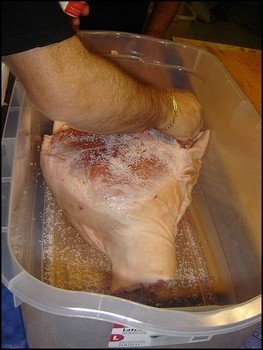Curing Ham and
Home Ham Curing Recipes Dry, Salt Brine and Sugar Curing Methods

Because of this, it is easier to experiment with a side of pork first before you attempt the whole leg of pork as it won't be a total economic disaster if things go wrong.
Also a ham will take longer to cure and is more difficult as a curing process. Once you get the meat curing process right, your ham will keep for 6 months to a year.
There are 2 methods of curing ham, one is to dry cure it where you rub a salt mixture into the pork and hang it up to dry, and the other is a wet cure where you place the pork in either a brine or a pickle and then hang it up to dry. The dry curing of ham is also called country style curing and is a slow method and your meat will keep longer this way than when cured using the wet cure method.
When curing ham make sure that your pork is not fatty. If you have a fatty leg you will run the risk of your meat spoiling more easily than if it is lean. Once you have killed your pigs make sure that the meat is chilled very quickly to prevent any spoiling taking place before you start the ham curing process. Once your meat is chilled start the curing process within 24 hours of slaughter, making sure that the internal temperature of your meat is at least 40 degrees Fahrenheit.
How long for Curing Ham?
Recipes for Curing Ham
The other thing is that these ham curing recipes call for saltpetre. If you are very lucky you may get this from either your local chemist or butcher, however it is now a restrictive substance as it can be used in bomb making. It is also linked to cancer and carcinogenic. Many people use curing salt as a substitute and would be a wiser choice all round.
Air-Dry Curing Ham Recipe 1
20lb rock salt6oz saltpetre
2oz sage
3oz bay leaves
1 1/2 oz garlic
6oz juniper berries
3oz black pepper
2oz nutmeg
1oz chives
2oz thyme
4oz coriander
Method:
Wash the hams and dry thoroughly. Put a bed of salt in a container and lay the hams down, making sure the container has a hole in the bottom to let excess fluid run off, Cover completely with the ingredients and leave until it is a good color.
After a week, break the pack, re-salt and place the hams skin down. Cover completely with salt and leave for one month. After a month take them out, wash thoroughly and tie a piece of good quality cotton twine around the hocks. Hang them up to mature for a week.
After a week, take them down and insert a long needle into each ham. Withdraw the needle and smell it. The aroma should smell fresh. If it does, take a small piece of fat, cover it with pepper and block the hole up with it; this prevents bacteria invading the ham.The next thing to do is to put the hams in the smoke house and smoke them using beech, for about a week. Take out cool, and put them in a cotton bag to mature.
These hams can keep for 12 months. They must be boned out very carefully and left under a press to compact the shape.
Air-Dry Curing Ham Recipe 2
30lb bay salt6oz saltpetre
4oz black pepper
6oz coriander
1 pint white wine vinegar
1 clove garlic
Method:
For the cure: mix together the saltpetre, salt, black pepper and coriander, Bone out the leg of pork and then apply the ingredients inside and out. Where you have taken the bone out, put some of the ingredients in, using 1oz to 1lb and then sew up near the hock to give a good shape to the ham.
Put the leg in a curing net to keep the shape. Do not hang it up but lay it down so it does not lose its shape.
Cure for 10 days, then fetch it out and wash it off. Apply the garlic and wine vinegar to the dry ham and put under a wooden press. Press into shape and leave for another week or so until it is completely hard. Take out the ham, rub it with garlic and vinegar and put in a muslin cloth.
Hang up in an airy place and leave for about a month. You may find mold when you remove it from the cloth. If the mold is white that is fine, just wipe it off with a cloth. However, if it is black this is not good, Rub it off with some more vinegar and re-wrap in a clean muslin.
Simple Salt Brine Recipe for Curing Ham
4 gallons water8 lbs salt
3/4 pound brown sugar
1/4 pound saltpetre
Method:
Leave it there for 3 weeks, then wash, and dry it off. Cover with a piece of muslin and hang it up to dry in an airy place.
You can also place it up the chimney and allow it to be smoked from the smoke from the wood fire if your have a large enough chimney.
Sugar Ham Curing Recipe
Take your pork leg and rub it with salt for 3 consecutive days. Then submerge your salted pork leg in the following pickle solution for 3 weeks.
4 gallons water
8 pounds black treacle
2 pounds salt
4 pounds brown sugar
2 oz black pepper
Method:
Boil the ingredients for 20 minutes in a large pot, remove from heat and cool. Submerge your pork leg completely in the solution and leave it there for 3 weeks. Take it out, and without washing it, allow it to air-dry slowly.
Old Fashioned Recipe for Curing Ham
For every 100 pounds of meat take 5 pints of good molasses or 5 pounds of brown sugar, 5 ounces saltpetre, 8 pounds of rock salt and add 3 gallons of water to a pot. Boil over a gentle heat, removing scum as it rises. Continue boiling until the salt and sugar have dissolved.With the meat cut and trimmed, pack the hams into the cask with the shank end down. Once the liquid has cooled poor over the hams in the cask making sure that they are completely covered.
The hams can lie in the pickle 2 - 6 weeks depending on the size of the hams, the time of the season etc. The warmer the weather, the shorter the time.
This recipe is a good substitute for curing ham rather than smoking or drying it.
| Countryfarm Lifestyles Tip: If you are wanting to make traditional proscuitto from wild boar, you only use the legs from female boars. The meat from male boars has an odd smell and therefore not used. |
Did you find this page helpful?
Sharing is a way of saying, "Thanks!"
Follow Us and Keep Up to Date
You can Add your Own Comments and Pages on Curing Ham!
We have lots of pages where you can contribute to throughout this website. We love hearing from our readers, and hope you will be one of those we hear from too. Look around our homesteading website. If you have any comments, recipes of your own, or questions, about curing ham, please feel free to contribute.
Leave a Comment
Do you have anything that you would like to add after reading this page? We would love to hear your thoughts. If you can add additional information to what has been written here you will be adding value to the website! No need to have any special skills - just type and submit. We will do the rest!
Other Comments
Click below to see comments from other visitors to this page...
What to do with fresh pork sides? 




I ordered 1/2 a hog and while answering questions from the butcher I ordered a fresh side of ham (bacon) instead of smoked. Not realizing the difference …
HAM CURING 




HAM CURING
There seems to be no fresh pork per Fl. Oz of curing mixture. Can we have some guidelines here, please?
Some very interesting recipes! …
Cajun way to remove "wild taste" from meats and fish 




I was just was reading up on ham curing, and they said not to use male boars, as their meat has a funny smell - it does! However this smell, and sometimes …
very salty homemade cured ham 




We salted our ham, hung it in a dry place for seven months. We tried it for the first time yesterday; it's edible but too salty. Is there any way to avoid …
Hog Hunting and Curing Meat Not rated yet
I grew up on a farm in the summers, with my grandparents. I was always present though for hog killing, dressing, & curing!
My Dad was a butcher. …







New! Comments
Do you have something of value to add? Leave me a comment in the box below.